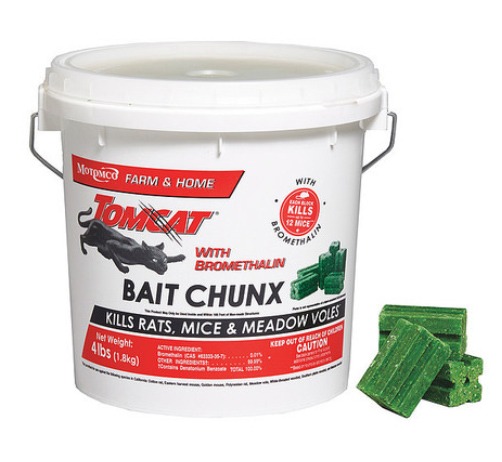-
Adopt
-
Veterinary Care
Services
Client Information
- What to Expect – Angell Boston
- Client Rights and Responsibilities
- Payments / Financial Assistance
- Pharmacy
- Client Policies
- Our Doctors
- Grief Support / Counseling
- Directions and Parking
- Helpful “How-to” Pet Care
Online Payments
Referrals
- Referral Forms/Contact
- Direct Connect
- Referring Veterinarian Portal
- Clinical Articles
- Partners in Care Newsletter
CE, Internships & Alumni Info
CE Seminar Schedule
Emergency: Boston
Emergency: Waltham
Poison Control Hotline
-
Programs & Resources
- Careers
-
Donate Now
 By Amanda Lohin, DVM
By Amanda Lohin, DVM
angell.org/emergency
MSPCA-Angell West
781-902-8400
Toxicities are an all too common presentation for the many species we see through the emergency service. One of the more common toxicities comes from ingestion of rat bait (a.k.a. rodenticides). Rodenticides come in many different forms, with different mechanisms of action to ultimately lead to death. Some rodenticide toxicities are very treatable, while others are not. The most treatable rodenticides are the anticoagulant rodenticides, while others, including Bromethalin (neurogenic), Cholecalciferol (leading to severely elevated calcium levels) and zinc phosphide (causing poison gas production) tend to be less treatable, although all toxicities are dose dependent. Below is a quick overview of each type of rodenticide, their mechanism of action and treatment options. If ever you suspect your pet has ingested any type of rodenticide, it is highly recommended to have them evaluated by a veterinarian and to consult an animal poison control center such as ASPCA Poison Control (1-888-426-4435).
Anticoagulant Rodenticides
Anticoagulant rodenticides are probably the most commonly used and the most frequent rodenticide toxicities seen through the veterinary emergency room. There are many different formulations in two categories: 1st generation and 2nd generation. 1st generation anticoagulant rodenticides (derivatives of “warfarin”, which is a commonly used anticoagulant in human medicine) last for approximately 7 days, but 2nd generation anticoagulant rodenticides generally last for 4 weeks. Anticoagulant rodenticides work by inhibiting the use of vitamin K in the body, and therefore they prevent the production of clotting factors dependent on vitamin K, leading to a coagulopathy (i.e. internal bleeding). Previously healthy animals should have adequate stores of these clotting factors, so clinical signs of bleeding after ingestion are usually not seen until these stores have been depleted, somewhere between 3-7 days.
If ingestion of these baits is known to be recent (within hours), standard decontamination protocols (inducing vomiting, use of activated charcoal) are warranted, followed by treatment with vitamin K therapy for anywhere from 7-30 days depending on the type of bait ingested (1st generation or 2nd generation). If ingestion of bait is suspected and the time frame is unknown or there are clinical signs of bleeding already present, clotting times should be checked to confirm a coagulopathy, followed by treatment to stop bleeding and replace blood loss (packed red blood cell and plasma transfusion) to stabilize, followed by treatment with vitamin K as described. Clotting times should be checked between 48-72 hours after finishing the prescribed course of vitamin K to ensure that further therapy is not warranted.
Bromethalin is a neurotoxic rodenticide which, unfortunately, has recently become more commonly used. This particular rodenticide works on the cellular level to cause swelling of cells within the central nervous system, which leads to swelling of the brain and increased pressure within the head (intracranial pressure). Bromethalin is fairly rapidly absorbed in the gastrointestinal tract. Clinical signs of toxicity can occur anywhere from hours to days following ingestion, depending on the dose. The signs that occur when a high dose is ingested typically include hyperexcitability, hyperthermia (increased body temperature), muscle tremors and seizures, and they occur within 2-12 hours of ingestion. When a lower dose is ingested, clinical signs are often delayed (1-4 days), and usually consist more of progressive ataxia (unsteady gait), decreased use of the hind end, decreased spinal reflexes, muscle tremors, decreased/dull mentation, GI signs (vomiting, anorexia, diarrhea) and abnormal eye motion (nystagmus, abnormal pupil size). Depending on the dose, these signs can progress over weeks to include paralysis, seizures, coma and death.
Unfortunately, there is no antidote for bromethalin toxicity. Treatment options for bromethalin ingestion/toxicity depend on timing following ingestion. If it has been <4 hours since ingestion, standard decontamination protocols (inducing vomiting and treatment with multiple doses of activated charcoal) are indicated to minimize absorption of the toxin, followed by supportive care for any clinical signs that may develop. If it has been >4 hours since ingestion, treatment is usually aimed more towards supportive care for clinical signs that develop (increased intracranial pressure and muscle tremors), as decontamination protocols will be less effective given the rapid absorption of the toxin. For animals who ingest a large dose of bromethalin and do not receive immediate intervention, the prognosis is poor. When it is not fatal, recovery may take days to weeks for the neurological signs to fully resolve and some animals can experience prolonged anorexia, requiring temporary feeding tube placement. At any point during toxicity, development of severe neurologic signs (i.e. seizures, coma or paralysis) carries a very poor to grave prognosis.
Cholecalcipherol (Vitamin D3)
Cholecalcipherol rodenticides cause increased absorption of calcium from the GI tract and decreased excretion of calcium through the kidneys, leading to increased levels of calcium in the blood (hypercalcemia) as well as phosphorus (hyperphosphatemia). When calcium and phosphorus reach a certain level in the blood and remains elevated for a prolonged period of time, this can lead to mineralization of the soft tissue of the body (kidneys, GI tract, liver, muscle including the heart, etc.). A diagnosis of cholecalcipherol toxicity is made based on history of exposure, clinical signs and consistent findings on blood work. Clinical signs can occur within 12-72 hours from exposure. Clinical signs include anorexia, lethargy, vomiting, diarrhea or constipation, GI bleeding, nausea, decreased motor function and elevated body temperature.
Much like other rodenticides, immediate treatment includes standard decontamination protocols (inducing vomiting, activated charcoal and cholestyramine) to minimize the amount of toxin absorbed. For animals who are already clinical or have an elevated calcium noted on their blood work, treatment with aggressive diuresis with fluid therapy and diuretic medication to increase excretion of calcium through the kidneys, steroids, and calcium binders can all be used to try and decrease calcium levels in the blood. If the phosphorus levels are also significantly elevated, phosphorus binders can be used. Follow-up blood work on a daily and then weekly basis is often recommended for up to 4 weeks.
Zinc Phosphide
Zinc Phosphide is one of the less commonly seen rodenticides, although it is rapidly fatal. This type of bait is commonly used for control of rats, mice, voles, gophers and prairie dogs. Zinc phosphide baits work by releasing phosphine gas in acidic environments (i.e. the stomach), which leads to respiratory distress, asphyxiation, gastric distention and acute abdominal pain, as well as obstructive shock. Once the phosphine gas has been produced, it causes massive cellular death. The onset of clinical signs can be rapid, and even more so on a full stomach as this will decrease the gastric pH (make the stomach more acidic). Clinical signs can be seen within minutes to hours of ingestion and can include lethargy, vomiting (with/without blood), wheezy/rapid breathing, unsteadiness, decreased mental awareness and seizures. When large doses are ingested, death can occur within 3-5 hours. Unfortunately, there is no antidote to zinc phosphide toxicity. The goals of treatment are focused on decontamination and decreasing the presence of gastric acidity to reduce toxicity below fatal levels. Decontamination includes inducing vomiting (in a well-ventilated area as the phosphine gas is also toxic to humans), gastric lavage (pumping the stomach) and treatment with activated charcoal and antacids, as well as basic supportive care (fluid support and treatment of shock, liver support).
Again, if at any point you suspect your pet may have ingested rodenticide, it is recommended to have them evaluated by a veterinarian immediately. Knowing the type of rodenticide, approximate amount ingested and approximate date/time of ingestion is very important information to help your veterinarian and animal poison control to know better what your pet needs for decontamination protocols and for treatment and prognosis.
